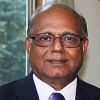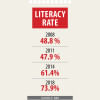The true purpose of literacy

On the UN-declared International Literacy Day observed on September 8, attention is turned to the status and progress of literacy rate, and platitudes are repeated. It does not leave the public and even policymakers much wiser about what should the aim of literacy be and how the aim may be reached. Attaining 100 percent literacy rate is pronounced by officials as the goal and a slow yearly progress in that direction is mentioned. What the hundred percent marker would really mean and what difference it would make in people's lives and for society remain fuzzy.
Per the official numbers revealed by the Bangladesh Sample Vital Statistics 2022 of the Bangladesh Bureau of Statistics (BBS), we have 74.4 percent literates among those aged 15 years and above. This is the age range used internationally for adult education rate. The comparable rate was 35.3 percent in 1991. These numbers suggest that the country's literacy rate has more than doubled in three decades.
The education authorities like to announce rates for other age ranges that seem to suggest a better performance in literacy. For example, the 2022 rate is claimed to be 76.8 percent for people aged seven and above. This number presumably includes the outcome of expanded primary education opportunities for children.
Literacy as a foundational skill for children's education is expected to be acquired in primary school. Youth and adults who miss out on primary education, as is the case in developing countries, need to be provided the means for catching up with the missed learning opportunities through alternatives such as adult education, life and livelihood skills development, and non-formal programmes.
Brazilian educator Paulo Freire had famously said literacy was about reading the world, not just the word. Since the 1948 Universal Declaration of Human Rights, which recognised the right to basic education for all, the definition of literacy has evolved from mere "knowledge of the alphabet" to functional skills and conditions for use of the skills for realising one's human potential.
Literacy as a foundational skill for children's education is expected to be acquired in primary school. Youth and adults who miss out on primary education, as is the case in developing countries, need to be provided the means for catching up with the missed learning opportunities through alternatives such as adult education, life and livelihood skills development, and non-formal programmes. Worldwide experience has established that quality primary education that enables children to acquire literacy and numeracy skills is the best way to tackle in a generation (a duration of some three decades) the problem of illiteracy in the population. Experience has also shown that campaign-style short-duration "alphabetisation" projects do not produce the desired outcome of literate adults who can acquire skills useful in their lives and continue further learning. Literacy for youth and adults have to be woven into meaningful learning opportunities relevant to their lives and work in a flexible and learner-friendly way.
On both fronts – quality primary education for children and flexible non-formal learning with literacy as a component for youth and adults – we have not yet managed to achieve the intended results. The National Learning Assessment carried out under the Directorate of Primary Education auspices has shown that the majority of children completing five years of primary education do not acquire functional competencies in reading and writing in Bangla and the four functions of arithmetic at a basic level. Since the 1990s, at least nine literacy projects have been carried out reaching a relatively small fraction of the potential youth and adult learners, and a tenth project was suspended during the Covid-19 pandemic. Education Watch studies and other educators have noted that these projects have been carried out as mechanical, "one size fits all" activities.
It would not be an exaggeration to say that these activities were carried out by the Bureau of Non-Formal Education (BNFE) exactly the way a meaningful and result-focused programme for youth and adults should not have been conducted – in respect of content, duration, teaching method, learning assessment, management and accountability. The content was focused on the mechanics of literacy, rather than relevant life and livelihood skills, with a uniform duration of six months for all, treating learners as children (rather than following andragogy principles for adult learning), and poor monitoring and accountability. The credibility and significance of literacy rates become questionable when seen in the light of primary education outcomes and the character of the literacy projects undertaken so far.
In a slight nod to the idea of meaningful literacy skills, BBS published the results of a survey on functional literacy skills in July this year. The functional literacy rate for seven-plus years in Bangladesh was found to be 62.92 percent. It was 60.77 percent for the internationally comparable 15-plus age range. The rates were determined by administering a literacy test calibrated to four varying levels of skills on a sample population. The four levels were: non-literate; familiarity with letters and ability to read some words; ability to read simple sentences; and ability at a more advanced level. Performers in the last two categories were considered functionally literate. The methodology and tools were developed by Education Watch for its literacy study in 2002 and also applied in Education Watch Report 2016. The reports found that the functionally literate adult population in Bangladesh was just over half of the population officially considered to be literate in the respective years. The BBS was urged to follow the "tested literacy" approach in reporting national literacy statistics, even if many developing countries do not do so.
Experience in Bangladesh and in other countries indicate that effective adult and non-formal learning are better undertaken by capable and dedicated NGOs, which are likely to be more flexible and responsive to the learners' needs and circumstances than a government agency with its bureaucratic constraints and culture. An appropriate partnership model between the government and NGOs and community-based organisations have not developed in the country. What we have now is contracts given to select NGOS for government-designated tasks.
BNFE Director Nuruzzaman Sharif said a five-year programme titled Non-Formal Education Development Programme (NFEDP) was being devised with the aim to cut illiteracy significantly. It is difficult to take this as good news for two reasons. First, a team of national experts worked on a comprehensive NFEDP in 2017-18 at the BNFE's behest, taking into account challenges and potentials as mentioned above. Decision-makers at the Ministry of Primary and Mass Education found it too radical for their taste, and it was shelved. Meanwhile, there have been frequent changes in the position of BNFE director-general, which is reserved for administrative cadre senior officers as a way station to other, more desirable postings. None of them has taken a serious interest or a lead in the proposed programme. Second, if there is an interest in the NFEDP mainly "to cut illiteracy rate," then it betrays the purpose of meaningful literacy as a component of non-formal education and lifelong learning.
According to media reports, the secretary for primary and mass education, Farid Ahmed, said the government was no longer interested in implementing projects through NGOs. I would like to hope this means he admits that the current objectives and method of implementing literacy projects are not working, and a new partnership approach with NGOs will be followed to achieve the true purposes of literacy.
Dr Manzoor Ahmed is professor emeritus at Brac University, chair of Bangladesh ECD Network (BEN), and adviser to Campaign for Popular Education (CAMPE). Views expressed in this article are the author's own.

 For all latest news, follow The Daily Star's Google News channel.
For all latest news, follow The Daily Star's Google News channel. 











Comments